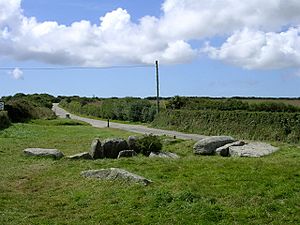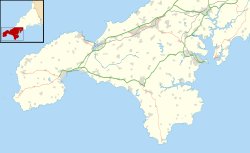Tregiffian Burial Chamber facts for kids
|
Hirvedh Treguhyon
|
|

Tregiffian Burial Chamber
|
|
| Location | Cornwall |
|---|---|
| Coordinates | 50°03′52″N 5°35′30″W / 50.064531°N 5.591786°W |
| Type | Chambered tomb |
| History | |
| Periods | Neolithic / Bronze Age |
| Site notes | |
| Ownership | English Heritage |
The Tregiffian Burial Chamber (which means Hirvedh Treguhyon in Cornish) is a very old tomb. It was built either in the Neolithic period (New Stone Age) or the early Bronze Age. You can find it near Lamorna in west Cornwall, United Kingdom. This tomb is a special kind of passage grave called an Entrance grave. It has a stone-lined path that leads into a main room. You can also find similar tombs on the nearby Isles of Scilly.
Contents
Where is Tregiffian Burial Chamber Located?
Tregiffian is in the southwest part of Cornwall. It is in an area called Penwith, south of Penzance. The tomb lies between the villages of St Buryan and Lamorna. It is also very close to The Merry Maidens stone circle. The Cornwall Heritage Trust looks after the site for English Heritage.
How Was Tregiffian Burial Chamber Built?
This large stone grave was mostly covered with soil. Only its entrance was visible. This is different from Cornish quoits, which were often more exposed. In 1846, a road was built, covering half of the tomb.
From the edge of the site, a passage led to the main burial room. This passage was covered by four large stones, each about 3 meters long. The burial room itself was about 4 meters deep.
Special Stone at the Entrance
Right in front of the main room, there was a special stone. This stone had unique cup-and-ring markings carved into it. It acted like a barrier to the tomb. The original carved stone is now kept safe in Truro. You can see it at the Royal Cornwall Museum. The stone you see at the site today is a copy. Inside the tomb, there was a chamber grave. It was made of upright stones with a flat stone on top. Tregiffian, the Merry Maidens, and other nearby sites likely formed a sacred area long ago.
Discoveries and Excavations at Tregiffian
People have studied the Tregiffian Burial Chamber for many years. The first major digs happened a long time ago.
Early Discoveries by William Copeland Borlase
In 1871, William Copeland Borlase started the first excavations. He first found the stone edge that covered the tomb. Inside, he discovered small pieces of flint, bones, and ashes. As he dug deeper, Borlase found pits with more bone remains. This suggested that people were cremated (burned) here.
Later Research and Finds
In 1932, a researcher named Hencken suggested that Tregiffian was a type of Megalithic grave. He thought it was built between the time of dolmens and cists. Newer studies now see these passage tombs as a special kind of dolmen. They are unique because of their clear entrance.
During big excavations in 1968 and 1972, archaeologists found urns. These urns were dated to around 1900 BC. Finding both cremated remains and urns is common for an Entrance grave. It shows that this tomb was used by a community for a very long time.



